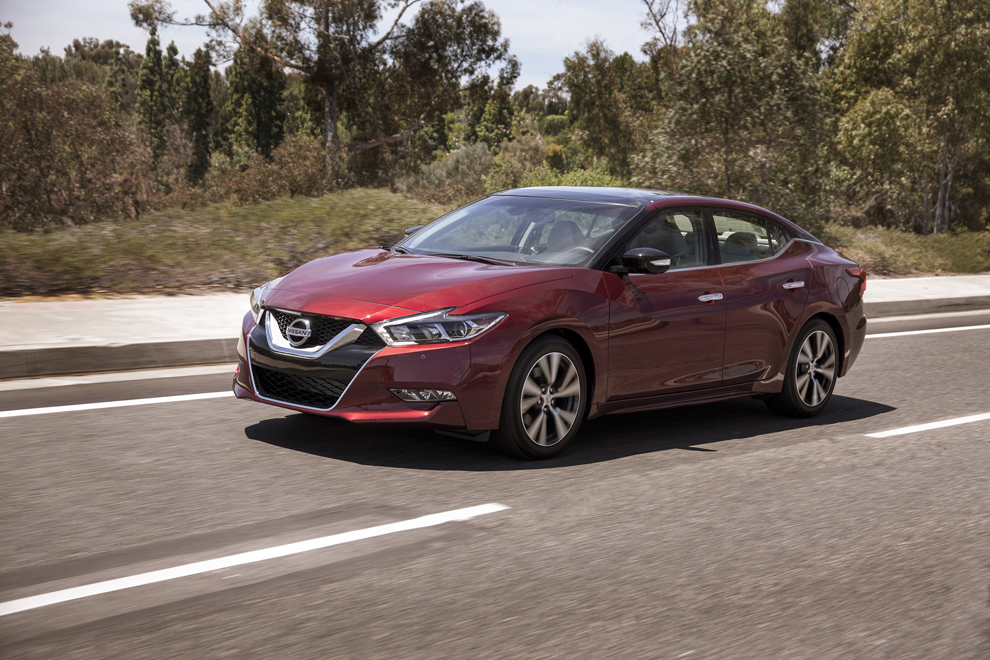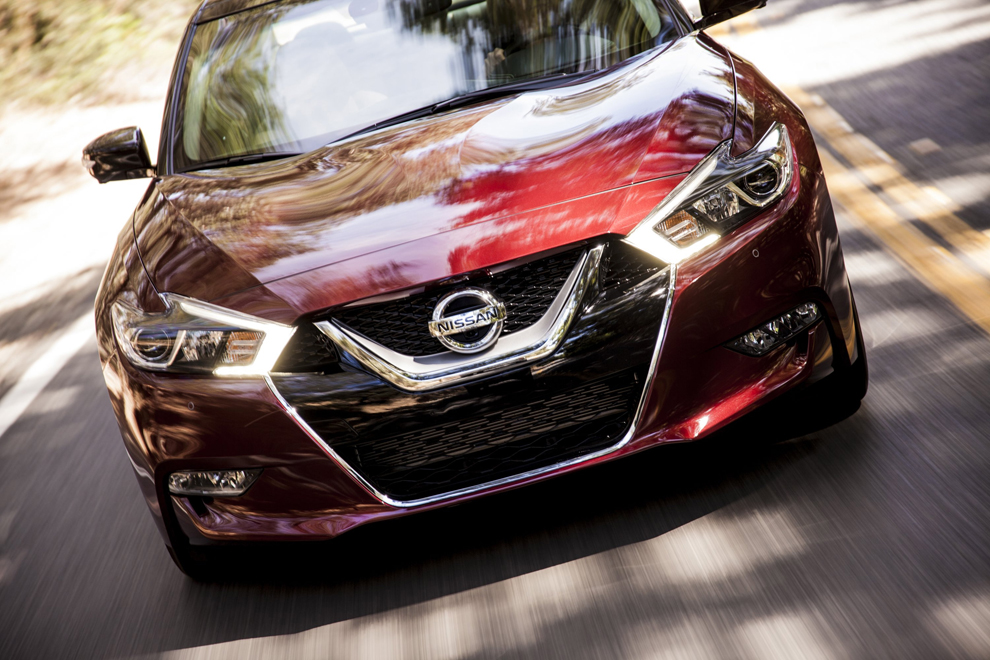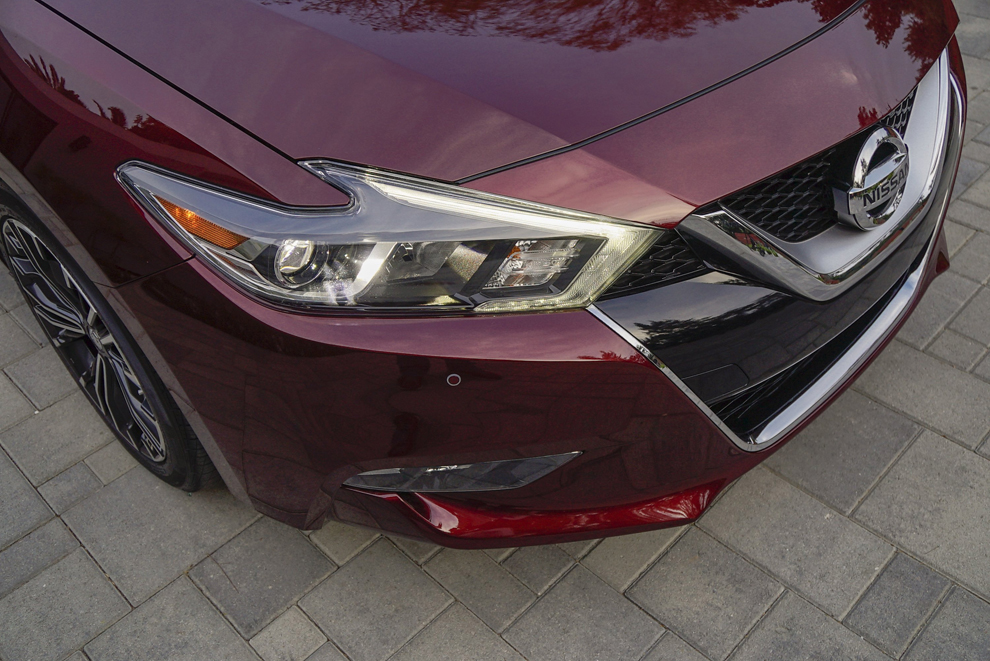The redesigned Nissan Maxima is like a new shoe. It looks sharp but feels better, and the more you wear it, the better it feels.
The Maxima is footwear that is both athletic and sophisticated, functional and stylish. You can schlep the kids in it, take it out for anniversary date night on the town, challenge its performance capabilities on the road and make the driver of an Infiniti Q70 work much harder for the extra $10,000 he spent on the premium brand.
It shares the same platform as the midsized Altima, but the sportier design unmistakably sets it apart from the more bland – and less expensive – Altima.
With the same wheelbase, but a little bit longer with a slightly lower roofline than the Altima, the Maxima no longer takes up the full-size sedan slot for Nissan.
The handlebar-shaped grille, part of Nissan’s “V-motion” branding on most of its new cars, extends outward down the beltline of the car. The windshield is long and slanted, the roofline sleek and low, and the curves are distinct enough for the car to attract attention without ever calling for it. And also like a new pair of shoes, it looks best in motion.
We didn’t drive it on the track, nor did we drive it much more aggressively than the legal limits. We drove it as most drivers will, but from a stop, the 261 pound-feet of torque kicking out of the beefed-up 3.5-liter V-6 engine is more than enough to put a smile on your face.
Front-wheel drive keeps it more composed than other sport sedans, and the steering isn’t as sharp as German sport sedans. Yet in most driving situations, it feels just fine.
Another element keeping the Maxima more on the sophisticated side rather than the sport side of the sedan world is the fuel-saving, continuously variable transmission.
But the improved CVT Nissan calls Xtronic also contributes to the impressive burst from a stop. Since there are no gear shifts, acceleration is uninterrupted.
Most CVTs announce themselves with droning boredom at cruising speeds, as if the engine is letting out one long, endless sigh. Not so with Nissan, as the automaker has tweaked the Maxima’s CVT to be nearly unnoticeable.
The torque is ready and willing at midrange speed, so blowing past more traditional on-ramp mergers and soaking up the lovely, throaty call of the V-6 is the driver’s recurring privilege. I loved this dual nature about the Maxima, and even though praising engine noise is typically reserved for V-8s, the Maxima sounds great.
In normal driving situations, you don’t hear much at all, which is a balance that few other cars have at this price point. Open it up and feel young at heart; tone it down and feel adult.
The Maxima stays relatively low to the ground, but is more sedan than sports car, so you don’t need a handle or a crane to get out. There are enough seat adjustments to comfortably set your visibility, a trait that is positively more sedan than sport car. That’s a good thing.
The top-of-the-line Platinum trim features diamond-patterned leather seats with 8-way power seat options and a thigh support extension that is part of Nissan’s “zero gravity” seats that spread out your load. OK. It’s a comfortable seat.
The heated seats have a loud fan, which is typical of Nissan and Infiniti cars we’ve tested. Otherwise, the cabin is as quiet as they come. The leather extends to the meaty flat-bottom steering wheel, and the thick, soft-clad dash gives the cockpit as much luxury as comfort.
On the doors and glove box, the diamond-angled trim is a fake wood material that is more curious than anything else.
Small touches make a big difference, and prove that the Maxima was designed for the driver. Blind spot warnings in other cars are usually a yellow-orange light that flicks on in the side mirror. It can be distracting in the periphery, or unnoticeable.
The blind spot warning on the Maxima is a soft orange rectangle on the inside of the door where it connects with the side mirror. It’s in line with the other controls and gauges inside the cockpit so it never feels like an alarm.
Other little touches include control knobs for volume and radio tuning, despite having an 8-inch touch screen and redundant steering wheel controls that get the job done.
There’s also a knob in the center console like Mazda and the German automakers have, as if Nissan isn’t quite sure which style to go with, so here’s all four. You decide. The voice commands were spot-on and map functions were easy to navigate.
Simplifications continue to the performance options. There are normal and sport buttons – the latter delays shift points and opens up the throttle noise a bit. The buttons are on the center console, and you don’t have to remove your elbow from the armrest to dial it up.
There is also an actual gear stick that you can flick into seven manual gears. There are no paddle shifters, which is unusual in such a car, but we didn’t miss them.
Calling it a sports sedan, as Nissan has done to distinguish it from the Altima, is like calling a Chuck Taylor a basketball shoe: not quite.
In the company of true performance sedans such as the Audi S6 and BMW 5-Series, the eighth-generation Maxima handles more like the smaller Mazda6, but with upscale interior like the larger Toyota Avalon. I’d take the Maxima over either of the last two, despite the drop-off in fuel efficiency.
Send questions/comments to the editors.





Success. Please wait for the page to reload. If the page does not reload within 5 seconds, please refresh the page.
Enter your email and password to access comments.
Hi, to comment on stories you must . This profile is in addition to your subscription and website login.
Already have a commenting profile? .
Invalid username/password.
Please check your email to confirm and complete your registration.
Only subscribers are eligible to post comments. Please subscribe or login first for digital access. Here’s why.
Use the form below to reset your password. When you've submitted your account email, we will send an email with a reset code.